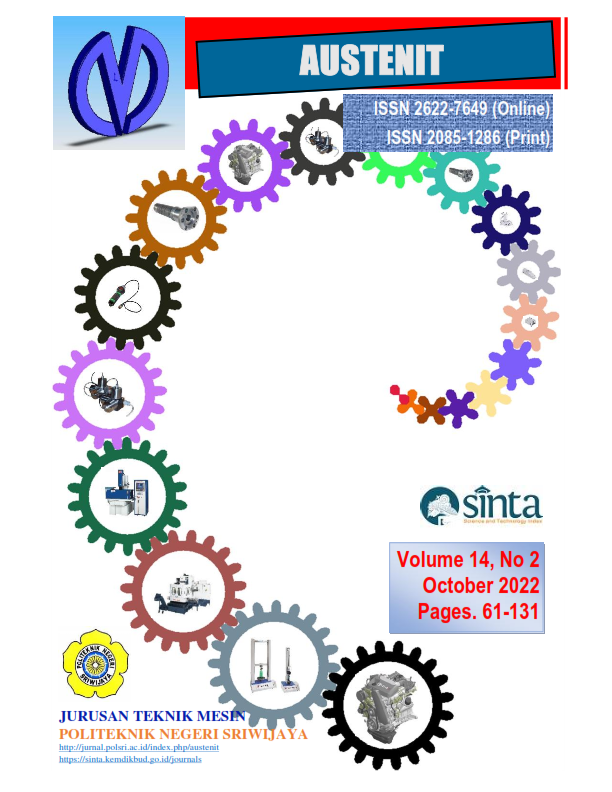THE EFFECT OF VARIATIONS SPEED OF THE CONDENSER FAN WITH CONTROL FREQUENCY INVERTER ON THE ICE SLUSH MACHINE APPLICATION
DOI:
https://doi.org/10.53893/austenit.v14i2.4955Keywords:
Ice slush machine, inverter, efficiency, Condenser, fan rotationAbstract
The condenser is one of the main components in the ice slush machine system that functions to removed heat from the system to the environment. In this system, the condenser is equipped with a fan whose rotation speed is modified using an inverter that aims to determine the system performance and condenser capacity at each fan rotation variation of the ice slush machine. There are 3 variations of frequency settings in this system 50 Hz, 40 Hz, and 30 Hz, with equivalent velocity air 3.6, 2.9, and 1.9 m/s respectively. In this study, the performance of the ice slush machine with various condenser fan speed settings was studied including, how long the product temperature is reached, condenser capacity, actual COP, efficiency, and electrical power. The test results show that the fastest product temperature is reached when using a fan speed setting of 1397 rpm, which is 145 minutes with a condenser capacity of 42.36 kW. The highest actual COP is obtained from the fan speed set at 1397 rpm of 2.58 with an efficiency of 57.5% and electrical power consumption of 269.64 W. The fan speed setting at 1090 rpm has a condenser capacity of 33.78 kW, COPactual of 2.46 with an efficiency of 56.2%, and electric power consumption of 272.09 W. The fan speed setting at 711 rpm has a condenser capacity of 21.73 kW, an actual CO of 2.15 with an efficiency of 49.2%, and electric power consumption of 312.71 W.
Downloads
References
DOE. (2015). An Assesment of energy technologies and research opportunities. Chapter 5 : increasing efficiency of building systems and Technologies.
Dossat, R. J. (1961). Principles of refrigeration.
Henry Nasution, K. S. (2014). Eksperimental study of air conditioning control system for builiding energy saving. Energy Procedia, 63–66. https://doi.org/doi:10.1016/j.egypro.2014.11.907
M. J. Moran dan H. N. Shapiro. (n.d.). Fundamentals of Engineering Thermodynamics (3rd ed.). John Willey & Sons.
Muliawan, R. (2020). Komparasi Penerapan Kinerja Inverter pada Sistem Refrigerasi dengan Alat Ekspansi Jenis TXV dan Pipa Kapiler. Teknik Energi Polban, 10(1), 7–13. DOI: https://doi.org/10.35313/energi.v10i1.2312
Muliawan, R. (2022). Predicting of refrigerant leakage in a conditioned room : a numerical study leaks distribution R-32 refrigerant in A/C Split Unit. ASEAN Engineering Journal, 12(2), 11–18. https://doi.org/10.11113/aej.v12.16499
Muliawan, R., A, A. A., Sutandi, T., & Nurrohman, N. (2021). Cooling System Performance Comparison of Refrigerant R-134a and MC-134 on Ice Slush Machine. FLYWHEEL : Jurnal Teknik Mesin Untirta, 7, 1–6. https://doi.org/10.36055/fwl.v0i0.9237
Stoecker. (1996). Refrigerasi dan Pengkondisian Udara. Erlangga.
Sumeru, K., & Sutandi, T. (2007). Penghematan energi pada mesin pendingin dengan variasi putaran kompresor. Teknik Mesin Institut Teknologi Sepuluh November, 7(2), 80–85.
Susilawati, A. S. (2017). Kajian Pengaruh Kecepatan Putar Kipas Kondenser Terhadap Konsumsi Energi Dan Kapasitas Pendinginan Mesin Tata Udara.
Wellid, I. (2019). Kaji experimental perbandingan kinerja pengkondisi udara antara menggunakan inverter dan non-inverter. Edusaintek Unimus. https://prosiding.unimus.ac.id/index.php/edusaintek/article/view/314/317
Widiyatmoko. (2018). Desain Modifikasi AC split menjadi Ac sistem geothermal sistem terbuka. Austenit, 10(2), 67–71. https://doi.org/10.5281/zenodo.4547654.
Downloads
Published
How to Cite
Issue
Section
License
Copyright (c) 2022 Authors and Publisher

This work is licensed under a Creative Commons Attribution-ShareAlike 4.0 International License.
The Authors submitting a manuscript do so on the understanding that if accepted for publication, Authors retain copyright and grant the AUSTENIT right of first publication with the work simultaneously licensed under a Creative Commons Attribution-ShareAlike License that allows others to share the work with an acknowledgment of the work's authorship and initial publication in this journal.
AUSTENIT, the Editors and the Advisory International Editorial Board make every effort to ensure that no wrong or misleading data, opinions or statements be published in the journal. In any way, the contents of the articles and advertisements published in AUSTENIT are the sole responsibility of their respective authors and advertisers.














